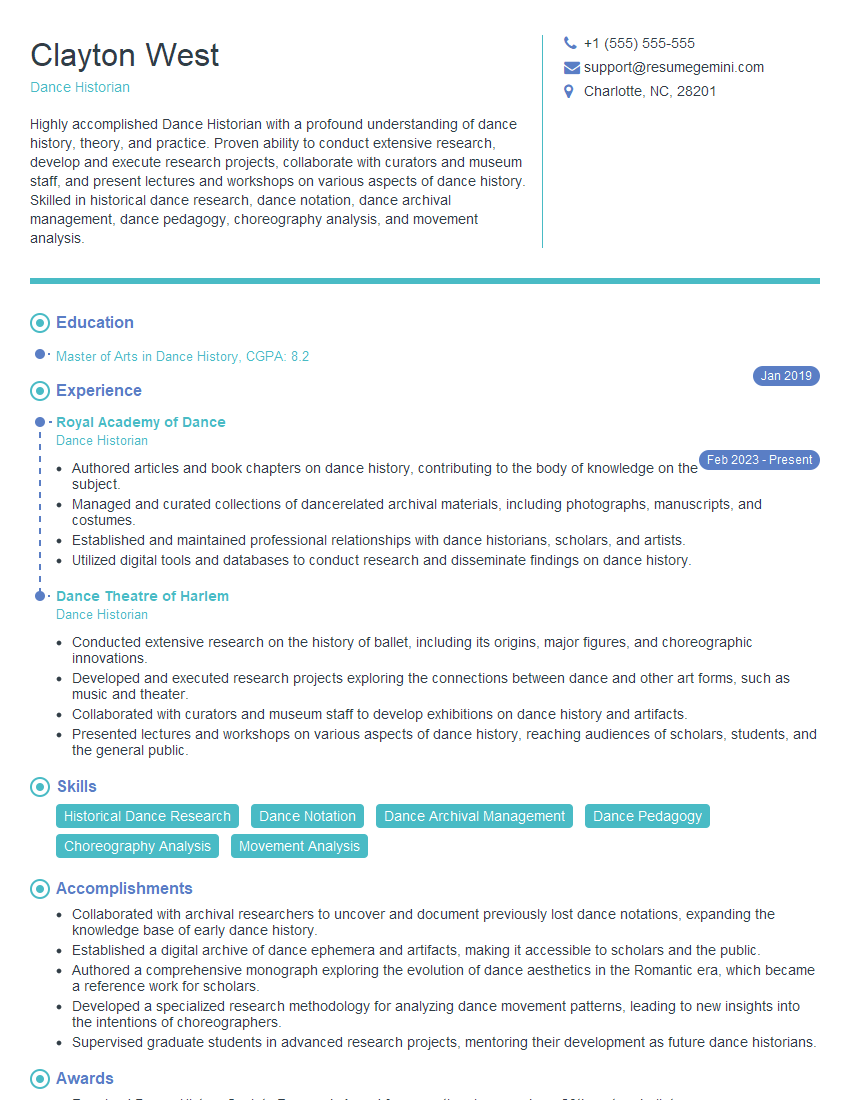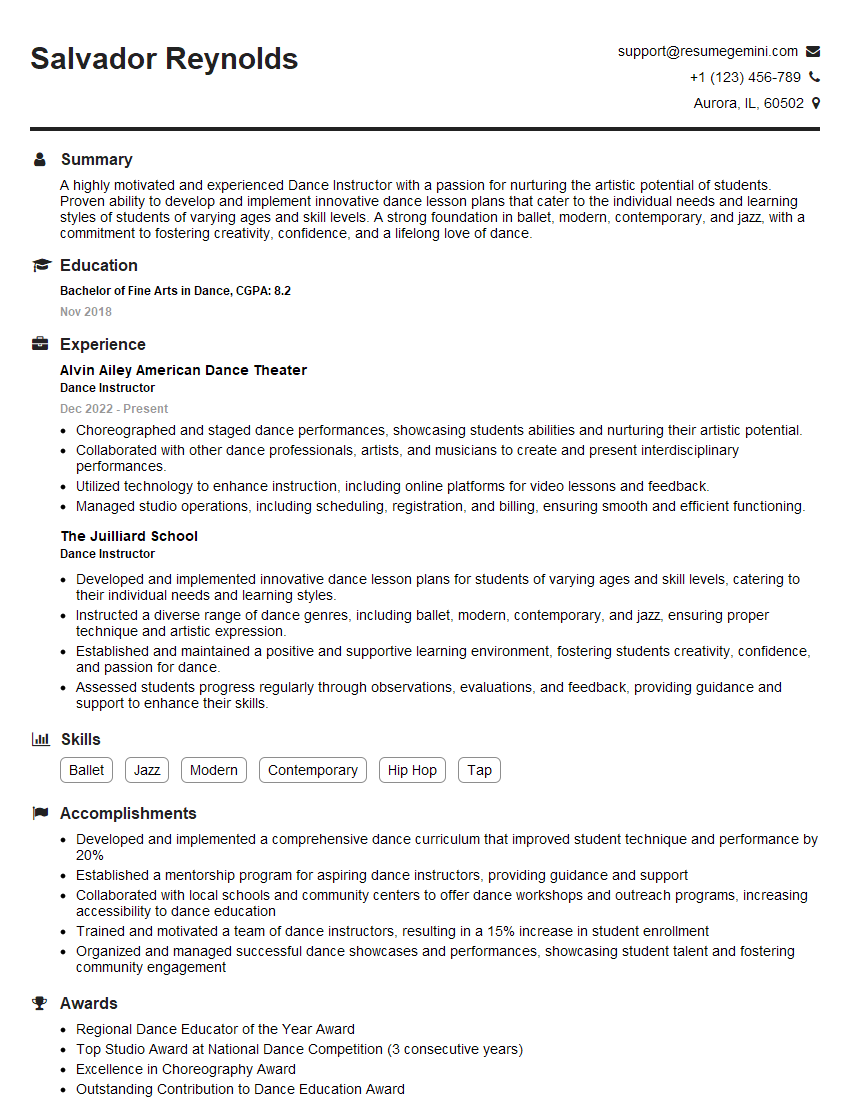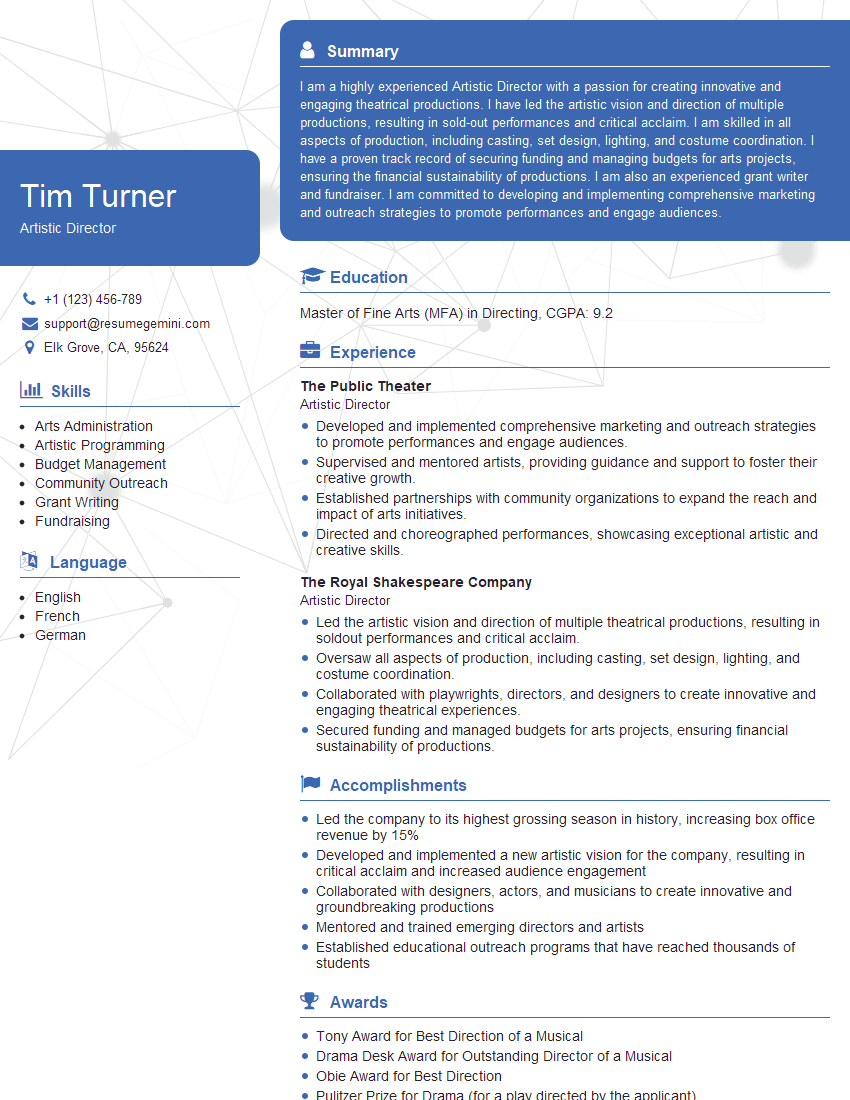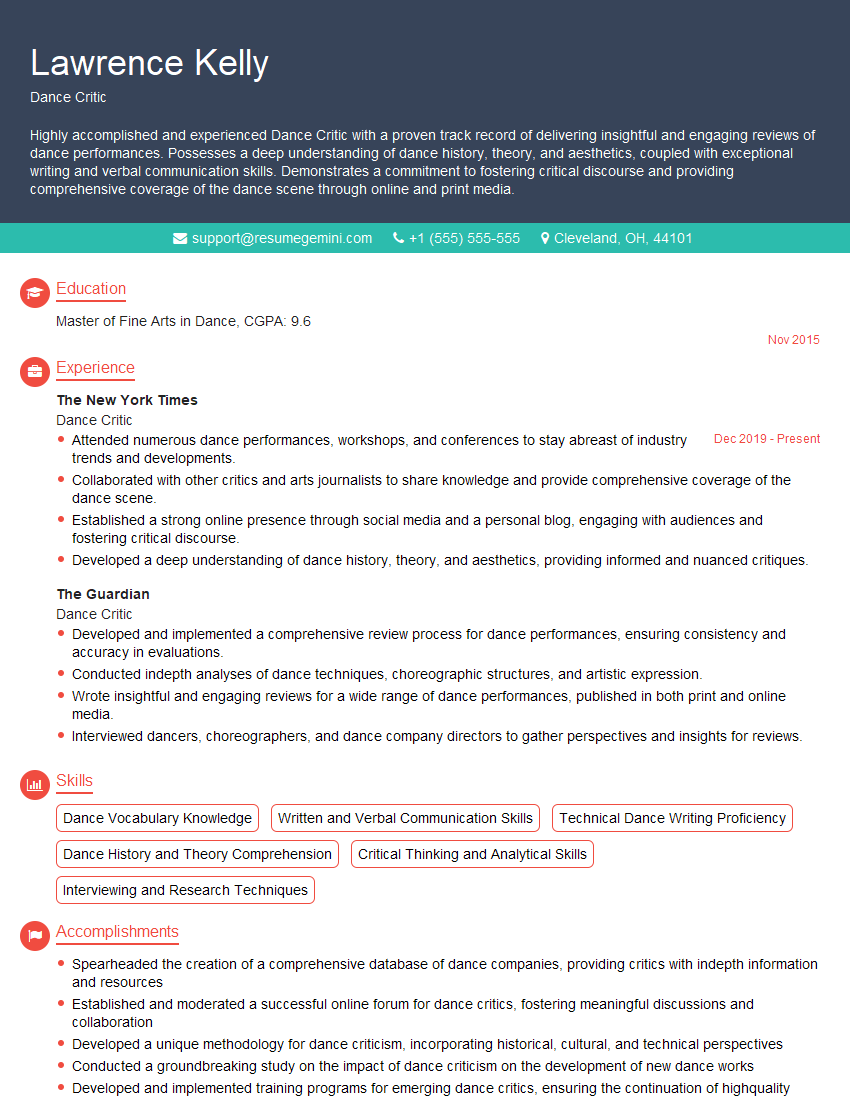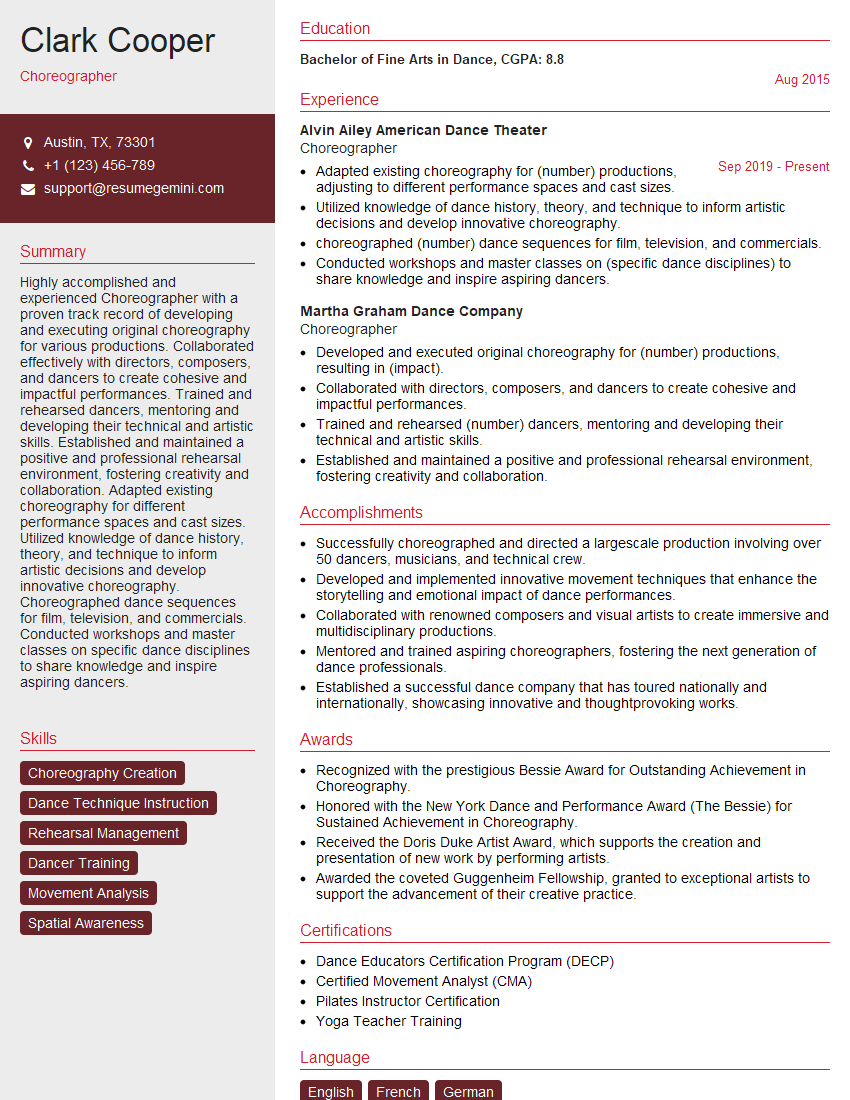Unlock your full potential by mastering the most common Dance Vocabulary Knowledge interview questions. This blog offers a deep dive into the critical topics, ensuring you’re not only prepared to answer but to excel. With these insights, you’ll approach your interview with clarity and confidence.
Questions Asked in Dance Vocabulary Knowledge Interview
Q 1. Define ‘plié’ and describe its variations.
A plié is a bending of the knees, a fundamental movement in ballet and many other dance forms. It’s crucial for building strength, flexibility, and control. Think of it as a controlled squat, but with a specific focus on technique.
- Demi-plié: A half-bend of the knees. Imagine dipping your knees only halfway down, keeping your heels on the floor (unless otherwise specified). This is frequently used as a preparatory movement before jumps or turns.
- Grand plié: A full bend of the knees, going as low as your flexibility allows, while maintaining proper posture and alignment. This is a powerful movement that stretches and strengthens leg muscles, often seen in the end of adagio sequences.
- Variations based on position: Pliés can be performed in various positions – first, second, third, fourth, and fifth – each affecting the alignment of the legs and the overall aesthetic.
For example, a demi-plié in fifth position prepares for a graceful arabesque, while a grand plié in second position is often a powerful ending to a sequence.
Q 2. Explain the difference between ‘arabesque’ and ‘attitude’.
Both arabesque and attitude are poses in ballet characterized by a raised leg, but they differ significantly in the position of the supporting leg and the overall aesthetic.
- Arabesque: The working leg is extended straight behind the body, creating a long, elegant line. The supporting leg is straight, and the body is aligned from head to toe. Imagine a graceful swan stretching out a leg. The supporting leg can be slightly bent.
- Attitude: The working leg is bent at the knee, often to a 90-degree angle, projecting the leg out to the side or slightly forward. This creates a more dynamic and energetic pose, unlike the stillness of an arabesque. Think of a dancer poised to spring into action.
In short, an arabesque is a long, flowing line, while an attitude is a more dynamic and assertive position.
Q 3. What is the significance of ‘port de bras’ in classical ballet?
Port de bras translates to ‘carriage of the arms’ in French. It refers to the specific way a dancer moves and positions their arms in ballet. It is NOT merely arm movements, but the way they are used to enhance the overall artistry, line, and expression. It’s an essential component of elegant movement and expressive storytelling in classical ballet.
Proper port de bras involves fluidity, grace, and precision. The arms are rarely stiff; they should flow seamlessly into the body’s movements, adding an extra layer of beauty and emotion to each step.
For instance, rounded arms during an adagio sequence can convey tenderness and softness, while more extended arm positions might express power and strength during a jump sequence. The subtle differences in arm placement can drastically change the mood and narrative of the dance.
Q 4. Describe the characteristics of a ‘grand jeté’.
A grand jeté is a large jump where the dancer projects themselves across the stage, executing a split in the air before landing. It is a powerful, spectacular movement requiring exceptional strength, technique, and control.
- The jump: The dancer takes off from one leg, using a strong développé (leg extension) and sissone (jump from two feet to one) to generate height and distance. They split in the air, achieving near-perfect extension.
- The split: In the air, the dancer achieves a near-perfect split, ideally maintaining a straight line from head to toe. It can be either an open split or a closed split depending on the style and choreographic context.
- The landing: The landing is crucial, requiring controlled balance and soft knees to prevent injury. The dancer lands gracefully on one foot, ideally in a held position.
Think of a gymnast’s vault, but with more focus on artistry, elegance and precise control.
Q 5. Explain the difference between ‘en dehors’ and ‘en dedans’.
En dehors and en dedans are directional terms in ballet that describe the rotation of the body and legs. They are fundamental to understanding turns and other movements.
- En dehors: This means ‘outward’. It refers to a rotation of the legs and body away from the center, meaning a turn from one leg to another in the outside direction.
- En dedans: This means ‘inward’. It refers to a rotation of the legs and body towards the center. Thus, a turn from one leg to another in the inner direction.
Imagine drawing a circle; en dehors would be turning outwards away from the centre of the circle, while en dedans would be turning inwards towards the centre.
Q 6. What is ‘épaulement’ and how is it used?
Épaulement refers to the elegant positioning of the shoulders and head in ballet. It involves a slight turn of the shoulders and head, creating a curved line that adds grace and elegance to the dancer’s posture. It’s about creating subtle yet expressive nuances in movement.
It’s not a static pose but a dynamic element, subtly shifting with every movement to maintain an aesthetically pleasing line. A dancer may subtly turn their shoulders and head to accentuate a particular limb or pose, enhancing the visual impact and overall artistic expression. For example, during an arabesque, a proper épaulement will enhance the line of the body, adding grace and visual appeal. This is not about a dramatic turn, but rather creating a subtle and elegant posture and line.
Q 7. Define ‘chasse’ and its variations.
A chasse is a gliding step where one foot chases the other. It’s a graceful and flowing step, often used as a linking step between more complex movements.
- Basic Chasse: One foot slides out to the side and the other foot quickly follows to close, effectively stepping to the side.
- Chassé forward/backward: A chasse can move forward or backward depending on the direction of the lead foot.
- Chassé en tournant: A turning chasse, where the dancer turns while performing the chasse. This is more advanced and needs good balance and control.
Imagine the smooth, gliding movement of a skater or the quick steps of a runner, but with precise control and elegance.
Q 8. What are the key elements of a ‘pirouette’?
A pirouette is a complete turn of the body on one leg, a fundamental movement in ballet and many other dance styles. It’s deceptively complex, requiring precise technique and control.
Spotting: This crucial element involves focusing on a single point in the distance (your ‘spot’) throughout the turn. As you turn, your head lags behind, ‘spotting’ the point to prevent dizziness and maintain balance. Think of it like a lighthouse beam – the spot remains stationary while the rest of the body rotates.
Rotation: The turn originates from a strong, centered core, initiating the rotation from the legs and hips, not just the shoulders. Imagine a corkscrew, winding tightly and smoothly.
Relevé: The dancer rises onto the supporting leg (the working leg is either extended or tucked), creating elevation and lift. This helps generate momentum and height for the turn.
Balance and Posture: Maintaining an upright, elegant posture throughout the turn is vital. A properly aligned body minimizes wobbling and maximizes rotation.
Preparation: The preparation or ‘setup’ before the actual turn is just as important. This includes a proper plié (bend of the knees) to initiate the movement and generate energy.
Imagine a figure skater spinning – that graceful, controlled motion is the essence of a well-executed pirouette.
Q 9. Explain the difference between ‘fouetté’ and ‘sissonne’.
Both fouetté and sissonne are jumps in ballet, but they differ significantly in execution and effect.
Fouetté: This involves a whipping action of the working leg, usually done in a series (fouetté turns are famous). The whipping action generates momentum, contributing to the turn. Imagine a ballerina repeatedly whipping a leg out to the side while rotating. The jump is relatively small, the focus is on the whipping action and the turn.
Sissonne: This is a jump from two feet to one foot (or two). It’s a more straightforward jump, often used as a transition or to cover distance. It emphasizes a light, springy quality, focusing more on the elevation and landing than a whipping action. Think of a light, elegant leap, potentially landing softly on one foot.
The key difference lies in the leg action – the whipping fouetté versus the more direct sissonne.
Q 10. Describe the various forms of ‘assemblé’.
Assemblé, meaning ‘assembled’ in French, is a jump where the dancer lands with both feet together, bringing them together in the air after leaving the ground from one foot. Variations depend on the starting and landing positions.
Assemblé à terre: The dancer jumps from two feet and lands with two feet. This is a simpler variation, often used as a preparatory movement.
Assemblé en tournant: The dancer jumps and turns in the air before landing with both feet together. This requires coordination and balance.
Assemblé from fifth position: The dancer begins the jump in fifth position and lands with both feet together in fifth position (or another specified position).
Assemblé from fourth position: Similar to the fifth position variation, but beginning in fourth position.
Variations in height and style: An assemblé can be a small, controlled jump or a larger, more dynamic one, depending on the choreography and the dancer’s skill.
Each variation modifies the look and feel of the movement, creating diverse possibilities in dance choreography.
Q 11. What is ‘contraction’ in modern dance?
In modern dance, ‘contraction’ refers to a specific movement of the torso. It involves curving the spine, often accompanied by a tucking of the pelvis and ribs. This creates a sense of inwardness and centeredness.
Imagine drawing your navel towards your spine, rounding your back, and letting your head fall forward. This inward curving of the spine is the essence of contraction. It’s a powerful movement that can express vulnerability, introspection, or a sense of gathering energy before a release.
Contraction is often used in conjunction with ‘release’ to create a dynamic interplay of movement and energy.
Q 12. Explain the concept of ‘release’ in contemporary dance.
‘Release’ in contemporary dance is the counterpoint to contraction. It’s the act of unwinding from a contracted position, lengthening the spine and extending the limbs. This often involves an exhalation of breath, further accentuating the sense of letting go.
Think of it as the uncoiling of a spring after it has been compressed. The release can be gradual and flowing, or it can be sudden and explosive, depending on the desired effect. It frequently creates a sense of fluidity, freedom, and expansion.
The interplay between contraction and release forms the basis of many modern and contemporary dance techniques, creating a dynamic flow of movement.
Q 13. Define ‘fall and recovery’ in modern dance.
‘Fall and recovery’ in modern dance is a technique that utilizes gravity and momentum to create expressive movement. The dancer intentionally allows their body to fall or collapse, then uses strength and control to regain balance and upright posture.
It’s not simply falling; it’s a controlled descent that often incorporates a precise sequence of actions and transitions. Imagine a dancer falling to the floor with deliberate grace, then using their core strength to roll over and rise to their feet. This controlled falling and subsequent recovery can be highly expressive, conveying emotions like surrender, resilience, or a struggle for balance.
The controlled nature of this technique differentiates it from uncontrolled falling; it requires great body awareness and strength.
Q 14. What is ‘parallel’ and ‘turnout’ in ballet?
‘Parallel’ and ‘turnout’ are fundamental positions in ballet technique, affecting the dancer’s alignment and the overall aesthetic of the dance.
Parallel: In this position, the feet are placed directly parallel to each other, pointing forward. It’s a common position in many dance styles but is less prevalent in classical ballet except for certain steps and exercises.
Turnout: This involves rotating the legs outwards from the hips, creating a wider range of motion and shaping the legs into a specific position. In ballet, turnout is often considered an essential part of technique, creating that distinct aesthetic quality and helping with stability in balances and turns. The ideal turnout is achieved through the rotation of the legs from the hip joints, not just at the knees.
The contrast between these two positions dramatically influences the style and feel of movement. Parallel positions appear grounded and direct, while turnout creates a more graceful and expansive aesthetic.
Q 15. Describe the difference between ‘spotting’ and ‘pointing’.
Spotting and pointing, while both involving focused gaze, serve distinct purposes in dance. Spotting is a technique primarily used in turns to maintain balance and orientation. Dancers fix their gaze on a single point in space, rapidly rotating their head to keep it aligned with that point while the rest of the body turns. This prevents dizziness and allows for a controlled, stable rotation. Think of it as a ‘visual anchor’.
Pointing, on the other hand, usually refers to extending a limb, often a foot or hand, in a precise and controlled manner. It’s a component of many dance styles and poses, used to create lines, shape, and emphasis. It’s less about maintaining balance and more about creating aesthetic impact.
Example: In a pirouette (a full body turn), a dancer uses spotting to maintain balance, while they might simultaneously point a foot to extend the line of their body and enhance the visual effect.
Career Expert Tips:
- Ace those interviews! Prepare effectively by reviewing the Top 50 Most Common Interview Questions on ResumeGemini.
- Navigate your job search with confidence! Explore a wide range of Career Tips on ResumeGemini. Learn about common challenges and recommendations to overcome them.
- Craft the perfect resume! Master the Art of Resume Writing with ResumeGemini’s guide. Showcase your unique qualifications and achievements effectively.
- Don’t miss out on holiday savings! Build your dream resume with ResumeGemini’s ATS optimized templates.
Q 16. Explain the importance of ‘musicality’ in dance.
Musicality in dance is the ability to interpret and express the music through movement. It’s not simply moving to the beat; it’s about understanding the nuances of the music—the rhythm, tempo, dynamics, phrasing, and emotion—and translating those elements into a physical language. A dancer with strong musicality will show a deep connection between their movements and the musical score. They’ll highlight the accents, reflect the changes in intensity, and convey the emotional arc of the piece.
Importance: Musicality makes a dance performance truly captivating. It breathes life into the choreography, making it expressive, engaging, and memorable. It elevates a technical performance into an artistic interpretation.
Example: A dancer performing a lyrical piece might use subtle changes in speed and weight to mirror the swelling and receding dynamics in the music. They might pause at significant musical phrases, allowing the music and their movement to resonate before continuing.
Q 17. What is ‘floorwork’ and its significance?
Floorwork encompasses any dance movement performed on the floor, often involving contact with the ground. It can range from simple rolls and slides to complex, acrobatic movements. This element is incredibly versatile and adds another dimension to choreography. Styles like hip-hop, contemporary, and jazz frequently utilize floorwork.
Significance: Floorwork allows dancers to explore different levels and perspectives, creating visual interest and dynamic transitions. It can express vulnerability, power, fluidity, or even a sense of groundedness, depending on the style and choreography.
Example: A contemporary dancer might use flowing floorwork to express sorrow and fragility, while a hip-hop dancer might utilize powerful, percussive movements on the floor to showcase strength and energy.
Q 18. What does ‘preparation’ mean in the context of a dance phrase?
In dance, ‘preparation’ refers to the movements leading up to a significant gesture, pose, or transition. It’s the ‘setup’ that precedes the main action. A well-executed preparation creates momentum, anticipates the action, and enhances its impact. It’s not just about the action itself, but also the journey leading to it.
Example: Before executing a powerful jump, a dancer might perform a preparatory movement such as a deep plié (bend of the knees), gathering energy and momentum. This plié isn’t just a separate movement; it’s an integral part of the jump, preparing the body for the height and power of the leap.
Q 19. Explain the terms ‘tempo’ and ‘rhythm’ in dance.
Tempo refers to the speed of the music and, consequently, the dance. It’s measured in beats per minute (BPM). A fast tempo might suggest energy and excitement, while a slow tempo can convey intimacy or solemnity.
Rhythm, on the other hand, is the pattern of sounds and silences in music. It’s the underlying pulse and the organization of beats into measures and phrases. In dance, rhythm dictates the timing and placement of movements, determining the feel and character of the dance. Dancers must accurately interpret and execute the rhythmic nuances of the music to achieve a coherent and expressive performance.
Example: A waltz has a slow tempo with a distinct 3/4 rhythm, whereas a jig has a fast tempo and a lively, often complex rhythm.
Q 20. Define ‘dynamics’ as it applies to dance performance.
In dance, dynamics refers to the variations in energy, intensity, and force used throughout a performance. It’s about creating contrast and highlighting specific movements through changes in speed, power, and expressiveness. It’s not just about the intensity of the movement; it’s about creating contrast and emotional depth.
Example: A dancer might perform a section of a piece with delicate, soft movements, followed by a burst of powerful, energetic movements. This dynamic contrast creates a more engaging and emotionally resonant performance.
Q 21. What is ‘improvisation’ and its role in dance?
Improvisation in dance involves creating spontaneous movement sequences without pre-planned choreography. It requires a deep understanding of movement principles, musicality, and body awareness. It’s a powerful tool for exploring creativity, developing technique, and expressing personal interpretations.
Role in Dance: Improvisation can be used in rehearsals to explore new ideas and develop choreographic concepts. It can be incorporated into performances as a means of showing flexibility, personal style, and interaction with the music. It allows for spontaneous emotional expression and enhances the dancer’s connection with the performance.
Example: A dancer might improvise a solo based on the feelings evoked by a particular piece of music, using the music as a guide for their spontaneous movements.
Q 22. Explain the difference between ‘ballet’ and ‘modern’ dance techniques.
Ballet and modern dance, while both expressive art forms, differ significantly in their technique and aesthetic. Ballet, with its centuries-old tradition, emphasizes precise, codified movements, turnout (rotation of the legs from the hips), and graceful, often elevated, positions. Think of the elegant arabesques and perfectly pointed feet. It often tells stories through narrative, mime, and established vocabulary.
Modern dance, in contrast, emerged as a rebellion against ballet’s strictures. It embraces a wider range of movement styles, often incorporating elements of other dance forms and focusing on the expression of emotion and individual experiences rather than rigid technique. Modern dance may involve floor work, contractions and releases, and less emphasis on classical lines and positions. Think of Martha Graham’s powerful contractions or Isadora Duncan’s flowing movements.
Essentially, ballet is a highly structured, codified system; modern dance is more fluid, experimental, and expressive.
Q 23. How does ‘spatial awareness’ affect dance?
Spatial awareness, or the understanding of one’s body in relation to the space around it, is fundamental to dance. It dictates where a dancer moves, how they occupy space, and how their movements interact with the environment. Without strong spatial awareness, a dancer might bump into other performers, misjudge distances for jumps, or lack fluidity in their transitions across the stage.
Imagine a dancer executing a complex series of turns. Without spatial awareness, they might lose their orientation, become disoriented, and risk falling or colliding with the set. A dancer with excellent spatial awareness will confidently navigate the stage, anticipate their movements in relation to others and the surroundings, ensuring a safe and aesthetically pleasing performance.
It’s not just about physical space; it also involves the dancer’s understanding of levels, pathways, and the use of negative space to enhance the choreography.
Q 24. Describe the meaning of ‘body alignment’ in dance.
Body alignment in dance refers to the proper positioning of the body’s skeletal structure to maintain balance, efficiency, and prevent injury. It’s about achieving optimal posture where the bones are stacked correctly, allowing for effortless movement and maximum range of motion. This involves aligning the head, shoulders, hips, and knees in a vertical line.
Poor body alignment can lead to strain, pain, and even serious injury. For instance, a dancer with poor spinal alignment may experience back pain and limited range of motion. Correct alignment ensures efficient energy transfer during movement, allowing for greater control and precision. Think of it like building a tower of blocks; if the base isn’t aligned, the whole structure becomes unstable.
Proper alignment is developed through mindful practice, careful attention to the placement of the body during exercises and sequences, and awareness of posture.
Q 25. What are the various levels in dance (high, medium, low)?
Dance utilizes various levels to create visual interest, dynamic movement, and emotional impact. The three primary levels are:
- High: Movements performed above the dancer’s center of gravity, often involving leaps, jumps, or extensions. This level creates a sense of exhilaration and power.
- Medium: Movements around the dancer’s center of gravity, involving steps, turns, and gestures that stay relatively close to the floor. It provides a sense of balance and stability.
- Low: Movements performed below the dancer’s center of gravity, often incorporating floor work, stretches, and low-to-the-ground positions. This level creates a sense of intimacy, vulnerability, and groundedness.
The interplay of these levels adds depth and dynamism to choreography. A sequence might start low, building momentum to a high jump before returning to a low, concluding pose.
Q 26. Explain ‘weight transfer’ and its importance in movement.
Weight transfer is the controlled shifting of body weight from one limb or body part to another. It’s the fundamental mechanism that allows for continuous movement and balance in dance. Efficient weight transfer creates fluid transitions between steps, turns, and poses.
Think of walking: You shift your weight from one foot to the other seamlessly. In dance, this same principle applies, but with greater control and precision. A dancer might transfer weight smoothly from one leg to the other during a turn, ensuring balance and stability. Inefficient weight transfer can cause jerky or awkward movements and could lead to falls or injuries.
Proper weight transfer is crucial for executing complex steps, jumps, and turns, resulting in a smoother, more graceful appearance.
Q 27. What is the significance of ‘line’ and ‘shape’ in dance?
Line and shape are essential visual elements in dance that contribute to the overall aesthetic and storytelling. Line refers to the dancer’s body’s extension and flow through space. It can be straight, curved, angular, or broken – each creating a different visual and emotional effect. A long, straight line suggests elegance and strength, while a curved line suggests fluidity and grace.
Shape, on the other hand, refers to the overall form or outline created by the dancer’s body or by a group of dancers. Shapes can be symmetrical or asymmetrical, geometric or abstract. A dancer might create a circular shape by extending their limbs, or a group of dancers might form a diagonal line across the stage. Shapes convey feelings, ideas, or even characters.
The interplay of line and shape is crucial in creating visually compelling and meaningful choreography.
Q 28. Describe the use of ‘motivation’ in creating a character through dance.
Motivation, in the context of dance characterization, refers to the driving force behind a character’s actions and emotions. It’s the internal impetus that fuels their movements, gestures, and overall portrayal. A strong motivation gives the character depth and believability.
For example, a character might be motivated by love, loss, anger, or ambition. This internal drive will inform how they move, their posture, their facial expressions, and even the speed and intensity of their actions. A character motivated by joy will move differently than one driven by grief. A dancer might use sharp, angular movements to portray anger, or slow, flowing movements to convey sadness.
Developing a strong motivation is crucial for creating compelling characters and bringing choreography to life. Understanding the character’s backstory, motivations, and emotional state allows dancers to inhabit the role fully and convey their story effectively to the audience.
Key Topics to Learn for Dance Vocabulary Knowledge Interview
- Anatomical Terminology: Understanding the names and functions of major muscle groups, bones, and joints relevant to dance movements. This allows for precise communication about technique and injury prevention.
- Movement Styles and Techniques: Comprehensive knowledge of vocabulary specific to various dance forms (e.g., ballet, modern, jazz, tap). This includes understanding the specific steps, positions, and stylistic nuances of each.
- Choreographic Notation Systems: Familiarity with systems like Labanotation or Benesh notation, enabling accurate documentation and interpretation of dance sequences. This is crucial for collaboration and preserving choreography.
- Dance History and Theory: A solid understanding of the evolution of dance styles and influential figures. This demonstrates a broader perspective on the field and allows you to contextualize your knowledge.
- Pedagogical Approaches: Knowledge of effective teaching methodologies and strategies for communicating technical concepts to dancers of different levels. This is particularly important for teaching or choreographic roles.
- Critical Analysis of Movement: The ability to deconstruct and analyze dance phrases, identifying key elements and articulating their artistic impact. This demonstrates an understanding of the creative process and insightful observation skills.
- Injury Prevention and Rehabilitation: Awareness of common dance-related injuries and strategies for prevention and rehabilitation. This demonstrates a commitment to dancer well-being and professional responsibility.
Next Steps
Mastering dance vocabulary is crucial for career advancement in the competitive dance world. A strong command of this terminology demonstrates professionalism, expertise, and clear communication skills, opening doors to more rewarding opportunities. To maximize your job prospects, create an ATS-friendly resume that highlights your skills and experience effectively. ResumeGemini can help you build a powerful resume tailored to the dance industry, showcasing your knowledge in a compelling way. Examples of resumes tailored to Dance Vocabulary Knowledge are available to help guide you through the process.
Explore more articles
Users Rating of Our Blogs
Share Your Experience
We value your feedback! Please rate our content and share your thoughts (optional).
What Readers Say About Our Blog
Hello,
We found issues with your domain’s email setup that may be sending your messages to spam or blocking them completely. InboxShield Mini shows you how to fix it in minutes — no tech skills required.
Scan your domain now for details: https://inboxshield-mini.com/
— Adam @ InboxShield Mini
Reply STOP to unsubscribe
Hi, are you owner of interviewgemini.com? What if I told you I could help you find extra time in your schedule, reconnect with leads you didn’t even realize you missed, and bring in more “I want to work with you” conversations, without increasing your ad spend or hiring a full-time employee?
All with a flexible, budget-friendly service that could easily pay for itself. Sounds good?
Would it be nice to jump on a quick 10-minute call so I can show you exactly how we make this work?
Best,
Hapei
Marketing Director
Hey, I know you’re the owner of interviewgemini.com. I’ll be quick.
Fundraising for your business is tough and time-consuming. We make it easier by guaranteeing two private investor meetings each month, for six months. No demos, no pitch events – just direct introductions to active investors matched to your startup.
If youR17;re raising, this could help you build real momentum. Want me to send more info?
Hi, I represent an SEO company that specialises in getting you AI citations and higher rankings on Google. I’d like to offer you a 100% free SEO audit for your website. Would you be interested?
Hi, I represent an SEO company that specialises in getting you AI citations and higher rankings on Google. I’d like to offer you a 100% free SEO audit for your website. Would you be interested?
good
